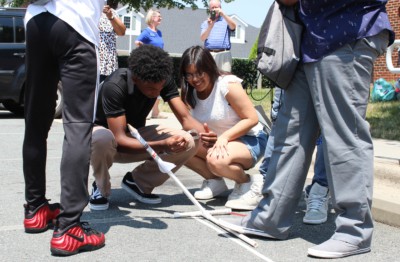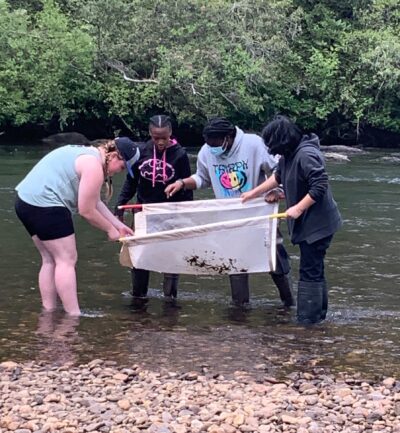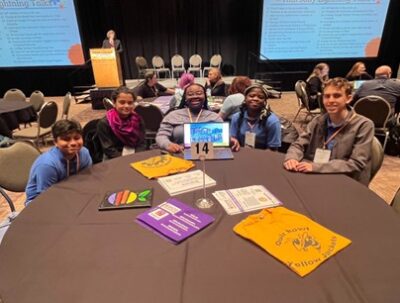
|
|
The children of Berlin were suffering. The war was right at their doorstep, and they had lost everything. Their plight touched the heart of an extraordinary World War II pilot named Gail Halvorsen. His response was to drop candy to the children from his squadron’s rations.
This piece of history was the foundational hook for a drone lesson carried out by Moore County elementary and middle school students, including our all-girl drone club, GLIDE (Girls Leading Innovation with Drones and Engineering).
Sound engaging? This mission incorporates math, physics, language arts, history, and geography. But more importantly, it provides an opportunity for students to practice empathy, teamwork, communication, perseverance, and problem-solving — all in a relevant, meaningful way.
As educators, we must cover various subjects involving a multitude of standards while facing increasing expectations to meet STEM benchmarks. Drones offer a compelling approach to accomplishing these objectives. Integrating drones into classroom activities enables educators to meet educational standards while optimizing student interest and participation at all grade levels.
There is also a collective desire for students to feel empowered and prepared for future career paths. It is widely acknowledged that our education system is undergoing a significant transformation, emphasizing STEM skills and social learning as vital components.
Drones are undeniably cool. In an era where educators grapple with captivating student attention, a drone is an engaging and meaningful tool. They’re also different than much of today’s educational technology in that they don’t rely on screens. Drones promote communication, collaboration, problem-solving, and relevance to real-world experiences.
Drones in society
Drones are driving innovation across industries. In agriculture, drones are enhancing productivity and efficiency through crop monitoring, pest control, and precision spraying. In infrastructure inspection and maintenance, drones provide cost-effective solutions for assessing bridges (and bridge disasters, both above and below the water), pipelines, and buildings. Emergency responders utilize drones for search-and-rescue missions, delivering supplies to remote areas and assessing disaster zones. Drones play a crucial role in aerial photography, filmmaking, and many other areas of the entertainment industry.
Drones are used daily in meaningful ways by the military, real estate firms, security companies, delivery services, and wildlife agencies. And that’s just a start.
GLIDE (Girls Leading Innovation with Drones and Engineering)
Research shows that women remain underrepresented in drone-related occupations, despite the growing demand for skilled drone pilots, technicians, and engineers. A 2022 Association for Unmanned Vehicle Systems International study found that only about 20% of commercial drone pilots are women. Women make up just 15% of the aerospace engineering workforce, a field closely tied to drone development and operations.
Initiatives that expose K-5 students, especially girls, to hands-on drone experiences have shown promise in sparking students’ curiosity and providing pathways to fulfilling careers in this rapidly evolving industry.
With this in mind, we developed GLIDE (Girls Leading Innovation with Drones and Engineering) with 12 4th and 5th-grade girls at Sandhills Farm Life School in North Carolina.
During GLIDE, an after-school club, the girls learn the skills necessary to pilot indoor Tello drones. In addition, they work through the Drone Legends STEM Fundamentals curriculum, a series of missions related to the real-life use of drones in our society. Drone Legends partnered with GLIDE providing all the curriculum materials without charge.
It is important that we expose our young girls to possibilities that may open amazing doors in their future.
Our drone experiences
We have learned so much over the last decade using drones with students:
Lessons in perseverance
Indoor drones provide valuable troubleshooting opportunities. They are lightweight, rugged, and safe when mistakes happen. Although the learning curve for flying an indoor drone is shallow, completing relevant missions can be much more challenging.
Leveling the playing field
Our classrooms are filled with amazing students who learn differently. Whether they are second-language learners, kinesthetic learners, neurodiverse, or experience a variety of learning differences, drones can make a vital connection. Students who are academically insecure or find traditional instruction challenging will find motivation when a drone lifts off.
Relevant learning
Today’s students struggle to see the relevancy between their in-school education and the real world. Integrating drones is a meaningful way to bridge this gap. When exposed to drone piloting from an early age, students are made aware of countless opportunities they may never have known existed.
Whether it’s launching objects like candy or back-burning dragon eggs to help battle wildfires, we have developed lessons that integrate drones into all aspects of the curriculum.
Learn more
In our upcoming session, “Sky’s the Limit: Elevate Your Curriculum With Drones!” in the series Not Your Average PD hosted by the Kenan Fellows Program for Teacher Leadership at N.C. State University, we will share additional approaches we’ve taken to ensure all students, not just our drone club, have experienced the thrill of learning with drones. Join us for this free session on Thursday, May 9 from 4:30-5:30 p.m. ET. We’ll share our experiences, sample lessons, and everything you’ll need to know about how to get started using drones to engage your students.






